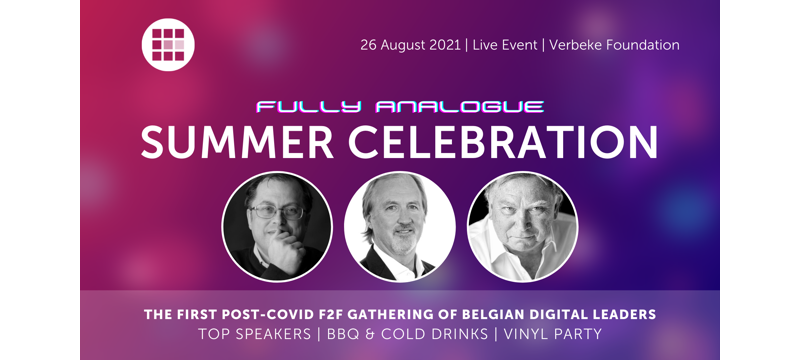Last week, I was asked to present a keynote at one of the first fully analogue events after having followed many virtual conferences from the safe and Covid-free environment of my home.
The assignment was: “Can you explain in less than 15 minutes how nerds like you succeeded in building a business?”
This is the draft I wrote in response to this question:
The Rise of the Nerds
“Be nice to nerds, you may end up working for them!”
Although this quote is often attributed to Bill Gates, it originally appeared in the book “50 Rules Kids Won’t Learn in School,” written by Charles J. Sykes.
It's not hard to imagine what caused the misquotation. Bill Gates, Jeff Bezos, Marc Zuckerberg, Elon Musk, Peter Thiel… are some of the richest and most powerful people in the world, but when they started their career, they were often frowned upon as nerds. One wonders how they were able to achieve success in business.
Which Factors Caused the Rise of the Nerds?
Although I’m not a billionaire myself, my personal story might shed some light on the matter. As a teenager, I was bad at sports, I loved Mathematics, Latin, and school in general. In short: I was a real nerd.
How did I become a successful entrepreneur and a multi-millionaire? Looking back, I see that three factors were important—for me, but also for the more famous tech tycoons I just mentioned.
Factor 1: Affordable Hardware
The first factor is the availability of hardware at an affordable price.
Up until the second half of the seventies, you only had access to a computer if you were an employee at a company that could afford buying one, or a student at a college that owned one. Then came the ALTAIR 8800 and the Homebrew Computer Club. Hobbyists started building their own computer, and this led to companies such as Apple, founded on April first, 1976.
I had my first computer in 1982, at the age of twelve, and I started my first business at the age of fourteen. Software was quite expensive back then, which forced me to write my own tools. As a teenager, I created a database system, and I used it to store addresses of different organizations in my hometown Ypres (in Belgium). When such an organization wanted to send out a mailing in the eighties, they had to manually write all the addresses of their members on envelopes. I solved this problem for them by selling pre-printed address labels. I bought sheets of labels for one Belgian franc a sheet (about half a cent), I printed the addresses from my database on those labels, and I sold them for two francs a sheet (about one cent).
Had I been twenty-four instead of fourteen, I could have become the “Label King of Flanders!” but I never had any customers outside of Ypres. Although I never made big money with my first venture, the experience was priceless.
Factor 2: Free and Open Source Software
The second factor that was crucial for my later success was free and open source software.
While the price of the hardware dropped in the late seventies, the cost of software was was getting higher and companies stopped sharing their source code. In the eighties, a developer at MIT came up with the concept of free software to counter this evolution. His name was Richard Stallman, and together with his team, he started writing a free operating system. In 1991, a twenty-one-year-old Finnish student, Linus Torvalds, started writing a kernel for this operating system, and this resulted in Linux, the free operating system we still know today.
In 1998, the term open source was coined for the first time. The new term reflected that free software wasn’t about price; it was about freedom and openness. Today, we use the words free and open in one breath when we talk about free and open source software—or FOSS. Suddenly, developers didn’t have to reinvent the wheel anymore. They could reduce the time needed to build an application by combining existing software components that they could use under liberal terms.
Also in 1998, I started my own open-source project that would result in the release of iText in the year 2000. iText is open-source software that is used by several thousands of companies to create and process documents in the PDF format.
With my pre-printed label business, my action radius was limited, but with iText I reached the whole world thanks to a third success factor that had emerged: the world wide web.
Factor 3: the World Wide Web
The availability of cheap hardware and free operating systems such as Linux, led to the explosion of the internet.
Hosting costs were affordable and for someone with technical skills, it became extremely easy to create a website. I benefited from this evolution when I released iText in 2000. Today, hardware can be rented by the hour, and the threshold to publish a product online has become lower than ever.
Recently, I saw a Tweet in which someone explained that you could launch your Minimum Viable Product for the price of a sandwich, thanks to free services such as GitHub, Slack, and the use of free AWS credits. When I released iText, AWS didn’t exist yet, nor did Google, but I used SourceForge and I experimented with GeoCities—names that probably don’t ring a bell anymore for the younger people among us.
A Missing Factor
In 2005, I was offered a book contract by a renowned American Publisher, and I enjoyed being famous in the world of software development.
That was great, but there was also a downside. When my son was diagnosed with cancer in 2008, I realized that I had been creating plenty of value for other companies, but that I had failed to create value for myself. Everyone was using my software without paying me for my work. With my son in the hospital, our financial situation didn’t look bright, to say the least.
With the three factors—inexpensive hardware, open source, and the world wide web, it was possible for a nerd to get noticed, but one important factor was missing to become successful: I had to find a way to monetize my open-source project.
In Search for a Business Model
I tried many different business models to make a living with iText.
I received donations from happy iText users, but donations don’t make a business. I made money by hosting ads, most of which were paid for by competitors. In a way, my competitors were my seed investors. In 2004-2005, I made between $1,000 and $1,500 a month with Google AdSense, but that revenue dropped dramatically in the years that followed. Counting on ad revenue isn’t a sustainable business model for open source. I also received royalties for my book, but not enough to further develop and maintain my project.
People told me that I should sell support or offer professional services working on projects for customers. While that seems to work for some companies, I didn’t think it would work for me.
One of the advantages of open source is that developers experiencing a problem, can take the code and fix it. As the license usually requires then to contribute those fixes back to the community, the product and its documentation get better and better, leading to a situation where potential customers say: “Everything works as expected; we don’t think we need paid support. Moreover, every question we had in the past, was adequately answered for free on platforms such as Stack Overflow.”
As for professional services, I didn’t see how I, as an individual, could compete with companies such as Northrop Grumman, Infosys, and all those other companies who had more money, more employees, more everything.
Commercial Open Source Software
I only started to generate real revenue with my open-source project after I made the license more restrictive. Starting in 2009, it was still allowed to use iText for free, but only if you used it in an open-source context. If you decided to use iText in a proprietary, closed source environment, you were obliged to purchase a commercial license.
My wife and I created a company that sold licenses very much the same way closed source companies sold software, the only difference being that customers had access to the source code and developers had the option to use the software for free if they met certain criteria.
Evolution of the Model
The first licenses we sold were perpetual. Customers paid a one-time fee and could then pay 20% each year for maintenance and support.
In 2013, the company made 4.5M euro in revenue with an EBITDA of 2.6M euro. That was nice, but to create real value for the company, we slowly migrated to a pay-per-use model, where companies paid a yearly fee based on the number of PDF documents they processed.
Toward Open Core
These models worked well for many years, but as open source became mainstream, more and more companies started to prefer paying for services rather than paying for software. Our licensing model came under pressure due to this evolution.
One one hand, we started developing specialized add-ons that remained closed source. On the other hand, we decided to put everything in place to extend our offer to SaaS, software as a service. Our new product, iText DITO, was to be offered in the cloud and we were going to sell subscriptions to customers, just like telcos sell subscriptions that allow you to use phone and data services.
It’s probably not a coincidence that this evolution from installing software on premise to using software as a service went hand in hand with an evolution from the restrictive open-source licenses we initially used, toward more permissive licenses, which are preferred by large SaaS companies such as Google and Microsoft.
My Personal Evolution
When I first started writing iText, I was only interested in the technology; “sales” was a dirty word for me. I learned the hard way that I was wrong. I discovered that sales were the fuel for further development, and that iText wouldn’t survive without sales.
From Nerd to Entreprenerd
I finally understood that building a business was very similar to building a machine, more specifically: a money machine. I was used to adapt my software to new evolutions in the PDF specification; It was fascinating for me to witness how changes in the world around us also required changes in the way we did business.
Entreprenerd: the Book
Eventually, my wife and I, who had bootstrapped the business together, sold our shares in the company. Today, iText Group is owned by three private equity firms backed by Peter Thiel.
After I left the company, I wrote a book about our journey from nerd to entrepreneur. It’s called: “Entreprenerd: Building a Multi-Million-Dollar Business with Open Source Software.” In this book, I summarized one of the most important lessons I learned from experience in a catchy quote:
“Good engineers build great technology; great engineers also create a sustainable business model.”
Non-technical people ask me to keep my book away from nerds, because once they discover this secret, the rise of the nerds will be unstoppable. Alas, I think it’s too late for that.
Entreprenerds already rule the world.



Oldest comments (0)